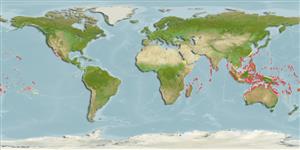>
Ovalentaria/misc (Various families in series Ovalentaria) >
Pomacentridae (Damselfishes) > Microspathodontinae
Etymology: Plectroglyphidodon: Greek,plektron = anything to strike with, spur + Greek, glyphis = carved + Greek, odous = teeth (Ref. 45335).
Eponymy: The Honorable George F Dick was Colonial Secretary of Mauritius and the President of the Natural History Society of Mauritius (1836–1850). He retired to his native Ireland. (Ref. 128868), visit book page.
Environment: milieu / climate zone / depth range / distribution range
Écologie
marin récifal; non migrateur; profondeur 0 - 20 m (Ref. 128797). Tropical; 30°N - 30°S
Indo-Pacific: East Africa to the Line and Tuamoto islands, north to Japan, south to Australia.
Taille / Poids / Âge
Maturity: Lm ? range ? - ? cm
Max length : 11.6 cm TL mâle / non sexé; (Ref. 124696); poids max. publié: 35.62 g (Ref. 124696)
Description synthétique
Clés d'identification | Morphologie | Morphométrie
Épines dorsales (Total) : 12; Rayons mous dorsaux (Total) : 16 - 18; Épines anales: 2; Rayons mous anaux: 14 - 16.
Adults inhabit coral-rich and surge areas of clear lagoon and seaward reefs (Ref. 1602). Commonly associated with Pocillopora or Acropora corals (Ref. 1602). Feed on filamentous algae, small benthic invertebrates, and occasionally small fishes (Ref. 1602). Oviparous, distinct pairing during breeding (Ref. 205). Eggs are demersal and adhere to the substrate (Ref. 205). Males guard and aerate the eggs (Ref. 205). Diurnal species (Ref. 54980; 113699).
Life cycle and mating behavior
Maturité | Reproduction | Frai | Œufs | Fécondité | Larves
Oviparous, distinct pairing during breeding (Ref. 205). Eggs are demersal and adhere to the substrate (Ref. 205). Males guard and aerate the eggs (Ref. 205).
Allen, G.R., 1991. Damselfishes of the world. Mergus Publishers, Melle, Germany. 271 p. (Ref. 7247)
Statut dans la liste rouge de l'IUCN (Ref. 130435: Version 2024-1)
Menace pour l'homme
Harmless
Utilisations par l'homme
Pêcheries: intérêt commercial mineur; Aquarium: Commercial
Outils
Articles particuliers
Télécharger en XML
Sources Internet
Estimates based on models
Preferred temperature (Ref.
123201): 25 - 29.3, mean 28.3 °C (based on 2789 cells).
Phylogenetic diversity index (Ref.
82804): PD
50 = 0.5010 [Uniqueness, from 0.5 = low to 2.0 = high].
Bayesian length-weight: a=0.02042 (0.01167 - 0.03573), b=2.98 (2.82 - 3.14), in cm total length, based on LWR estimates for this species & (Sub)family-body (Ref.
93245).
Niveau trophique (Ref.
69278): 3.7 ±0.3 se; based on diet studies.
Résilience (Ref.
120179): Haut, temps minimum de doublement de population inférieur à 15 mois (Preliminary K or Fecundity.).
Fishing Vulnerability (Ref.
59153): Low vulnerability (10 of 100).
Nutrients (Ref.
124155): Calcium = 99.9 [49.4, 166.6] mg/100g; Iron = 0.679 [0.390, 1.141] mg/100g; Protein = 18.6 [17.4, 19.7] %; Omega3 = 0.119 [0.069, 0.199] g/100g; Selenium = 19.1 [10.3, 38.1] μg/100g; VitaminA = 119 [35, 402] μg/100g; Zinc = 1.48 [0.97, 2.16] mg/100g (wet weight);
